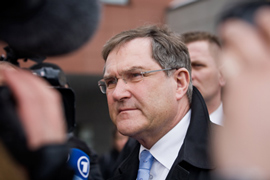Nato lukewarm on US troop call
Appeals to boost forces in Afghanistan meet with cool reaction in Europe.

‘Little to contribute’
The UK, which has the second largest force in Afghanistan, said it had made no decision on whether to send more troops.
| Major military deployments in Afghanistan |
|
|
John Hutton, the British defence secretary, said it was up to other Nato countries to step up their commitments first.
Germany, which confirmed a pledge of 600 more soldiers that it first made earlier in the year, rejected calls by Gates for troops from Nato’s Response Force (NRF) to be deployed to Afghanistan.
“The NRF should not be used as a reserve,” Franz Josef Jung, the German defence minister, said. “The NRF has fundamentally different tasks.”
Italy has said it will send 500 more troops by April.
Crispian Cuss, a military analyst and former British army officer, told Al Jazeera: “Seventy per cent of European forces can’t even operate beyond their own boundaries … there is very little they can contribute.”
“In some ways, the US were threatening Nato, saying, ‘if you don’t contribute to troops in Afghanistan, then what use are you in the modern world?’.
“That sort of threat has come home to roost, and people may now ask, ‘what sort of use does Nato have?’ And you might see America giving it even less attention that it has in the past.”
‘European reluctance’
Barack Obama, the US president, authorised 17,000 more US troops for Afghanistan this week, taking the US contingent to around 55,000, in addition to the 30,000 from 40 other mostly Nato countries already operating in Afghanistan.
Al Jazeera’s Hamish Macdonald, reporting from Kabul, said: “It’s not just that the United States wants other Nato member states to commit more soldiers, they also want them to commit them to the areas where the heaviest fighting has been taking place.”
Paul Burton, the director of policy analysis at the International Council on Security and Development, told Al Jazeera a small number of countries are being forced to fight in Afghanistan because of Europe’s reluctance to send troops.
“If you take a sweep of the European capitals of Nato-member states, unfortunately, you see a real reluctance from countries such as Germany, and Italy, to send the troop levels that are required to turn around the fight against the insurgency in Afghanistan.”
‘Appalling indictment’
“A small number of states – Canada, Australia and the Netherlands – are fighting on their own an increasingly violent battle.”
 |
| Germany’s Jung criticised plans to deploy the Nato rapid-response unit to Afghanistan [AFP] |
“Nato has thousands of helicopters. We have only managed to put a very few in Afghanistan and that is an appalling indictment of Nato’s inability to get behind very mission-critical operations,” he said.
Jaap de Hoop Scheffer, Nato’s secretary-general, said he wanted the alliance to
develop a “new strategic concept” to meet challenges its founders could never have imagined.
De Hoop Scheffer said the new concept would replace a Europe-centric concept that did “not take into account many of the key political and security events of the early 21st century”.
His new plan would guide the alliance in confronting terrorism, cyber attacks and even problems resulting from climate change.

 US: 55,000 (north, east and Kabul)
US: 55,000 (north, east and Kabul)